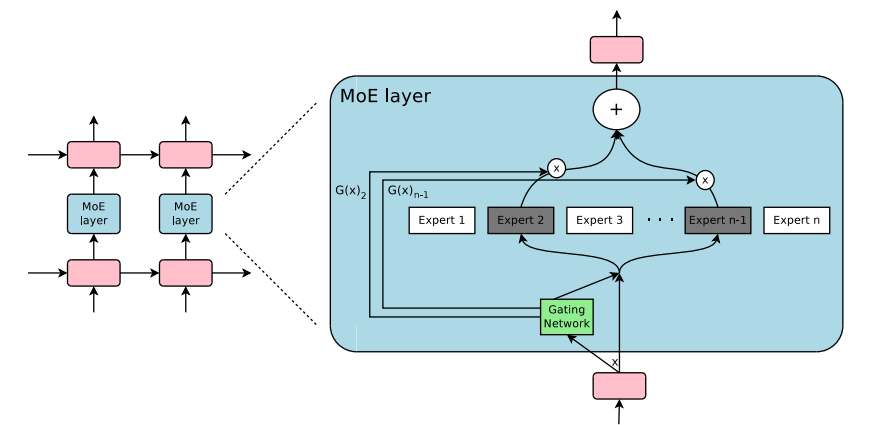
The MoE Revolution: Unpacking the GPT Architecture Shift That’s Redefining AI Scaling
The Architectural Blueprint: What is a Mixture of Experts Model?
For years, the dominant narrative in large language model development, a key topic in GPT Models News, has been one of brute force: bigger is better. The prevailing wisdom, largely validated by the success of models like GPT-3, was that scaling up the number of parameters in a “dense” architecture directly correlated with increased capability. In a dense model, every single parameter is activated to process every single input token. Imagine a massive, monolithic brain where every neuron fires for every thought, no matter how simple. This approach, while effective, has led to an arms race with skyrocketing computational costs, making state-of-the-art model training an exclusive club for a few tech giants.
However, recent developments in GPT Architecture News signal a dramatic paradigm shift. The industry is rapidly pivoting towards a more elegant and efficient design: the Mixture of Experts (MoE) architecture. This innovative approach challenges the “bigger is always better” mantra by introducing a new variable: computational intelligence. Instead of one giant, monolithic network, an MoE model is composed of numerous smaller, specialized “expert” networks and a “gating network” or “router” that intelligently directs input to the most relevant experts.
From Dense to Sparse: A Paradigm Shift
The core innovation of MoE lies in the concept of sparse activation. Think of it as moving from a general practitioner to a team of specialists. When you have a specific problem, you don’t consult every doctor in the hospital; you’re routed to the one or two specialists best equipped to handle your case. Similarly, in an MoE model, for any given input token, the gating network selects a small subset of experts to process it. This means that while the model might have a staggering total parameter count (e.g., over a trillion), the number of *active* parameters used for any single computation is a fraction of that total. This is a fundamental departure from the dense architecture of models like GPT-3.5 and a crucial piece of recent GPT-4 News, as many researchers believe GPT-4 leverages this very technique.
The Core Components: Experts and the Gating Network
Understanding MoE requires looking at its two primary components:
- The Experts: Each “expert” is typically a feed-forward neural network, essentially a smaller, self-contained language model. Each one can, over time, develop a specialization for handling certain types of data, patterns, or concepts—be it programming logic, poetic language, or factual recall. This specialization is a key area of ongoing GPT Research News.
- The Gating Network: This is the traffic controller of the architecture. It’s a small, nimble neural network that examines each incoming token and decides which expert(s) are best suited to process it. The gating network’s efficiency and accuracy are critical to the overall performance of the MoE model. It learns, through training, how to route tasks effectively, which is a significant advancement in GPT Training Techniques News.
This architectural choice fundamentally alters the economics of scaling. It allows developers to dramatically increase the model’s total parameter count—its “knowledge base”—without a proportional increase in the computational cost of inference or training, a breakthrough that is reshaping conversations around GPT Scaling News and the future trajectory of AI development.
Efficiency by Design: Analyzing the Cost-Performance Benefits of MoE
The theoretical elegance of the Mixture of Experts architecture translates into tangible, game-changing benefits in terms of computational cost and performance. By moving from a dense, all-hands-on-deck computational model to a sparse, specialist-driven one, MoE fundamentally rewrites the cost-benefit analysis of building and deploying large-scale AI systems, impacting everything from GPT Inference News to hardware requirements.
Sparse Activation vs. Dense Computation

Let’s consider a concrete, albeit hypothetical, example to illustrate the difference. A dense model with 175 billion parameters (like GPT-3) uses all 175 billion parameters for every single token it processes. The computational cost, measured in Floating Point Operations (FLOPs), is immense and constant.
Now, consider an MoE model with a total of 1.4 trillion parameters, arranged as, say, 16 experts. The gating network might be configured to route each token to the top 2 most relevant experts. In this scenario, while the model’s total size is 8x larger than the dense model, the number of active parameters for any given token is only the size of those two experts (e.g., ~175 billion parameters). The result is a model with the vast knowledge capacity of a trillion-plus parameters but the approximate inference cost of a much smaller dense model. This breakthrough is central to the latest GPT Efficiency News, promising faster response times and lower operational costs for services built on GPT APIs News.
Training and Inference: A Tale of Two Efficiencies
The benefits of MoE apply to both phases of a model’s lifecycle:
- Training Efficiency: During training, the computational load per training step is determined by the active parameters, not the total. This means researchers can train models with far more parameters than would be feasible with a dense architecture on the same hardware. This is accelerating progress and is a hot topic in GPT Training Techniques News.
- Inference Efficiency: For end-users and businesses, this is the most critical advantage. Faster inference means lower latency (quicker answers from GPT Chatbots News) and higher throughput (more users served simultaneously). This makes deploying powerful models for real-world GPT Applications News—from GPT in Healthcare News analyzing medical texts to GPT in Finance News processing market data—more economically viable.
The Memory Trade-Off: A Key Consideration
However, MoE is not a silver bullet without trade-offs. The most significant challenge is memory. While computation is sparse, the entire model—including all experts—must be loaded into the GPU’s VRAM during inference. This creates a high barrier to entry in terms of hardware, demanding setups with massive amounts of high-bandwidth memory. This reality is driving trends in GPT Hardware News, pushing for more powerful and memory-rich GPUs and specialized AI accelerators. This memory requirement is a critical factor in GPT Deployment News, making on-premise or edge deployments challenging without advanced optimization techniques like GPT Quantization or model pruning.
Ripples Across the Industry: The Ecosystem-Wide Impact of MoE
The shift towards Mixture of Experts is more than just a technical update; it’s a seismic event that is reconfiguring the entire AI landscape. Its implications extend far beyond architectural diagrams, influencing market dynamics, democratizing access to powerful AI, and setting a new course for future innovation. This is a core theme in current GPT Ecosystem News and is redefining the competitive landscape.
Democratizing Power: The Rise of Open Source Challengers
For years, the open-source community struggled to keep pace with the massive, proprietary models from giants like OpenAI. The prohibitive cost of training dense models at scale created a significant moat. MoE changes this equation. As highlighted by the latest GPT Open Source News, organizations can now build and release models with massive parameter counts that achieve performance competitive with, or even exceeding, closed-source models like GPT-3.5-turbo. This development is a huge boon for innovation, allowing smaller companies, academic institutions, and even individuals to experiment with, fine-tune, and build upon state-of-the-art AI. This trend is fueling a surge in GPT Competitors News, fostering a healthier, more diverse market where progress is not dictated by a single entity.
The Future of Customization and Specialization

The inherent structure of MoE models opens up exciting possibilities for customization. The “expert” design is a natural fit for domain-specific adaptation. We can envision a future, often discussed in GPT Custom Models News, where a base model can be enhanced by training or “plugging in” new experts specialized for specific fields. For example, a healthcare organization could develop a set of experts trained on medical journals for a GPT in Healthcare News application, while a law firm could do the same with legal precedents for GPT in Legal Tech News. This modular approach to fine-tuning could be far more efficient than retraining an entire dense model, a key topic for the future of GPT Fine-Tuning News and the development of specialized GPT Code Models News.
Rethinking the Scaling Laws and the Road to AGI
The rise of MoE forces a re-evaluation of the “scaling laws” that have guided AI research. The simple relationship between dense parameter count, data, and performance is now more nuanced. Researchers are exploring new scaling dimensions, such as the number of experts, the ratio of experts activated per token, and the sophistication of the gating network. This research is at the forefront of the quest for more capable and efficient AI and will undoubtedly influence what we see in future GPT-5 News. As models become more complex and specialized, this architecture could be a stepping stone toward more sophisticated systems, including autonomous GPT Agents News that can reason and act across various domains.
Navigating the MoE Landscape: Best Practices and Future Outlook
While the Mixture of Experts architecture represents a monumental leap forward, successfully implementing and deploying these models requires navigating a new set of technical challenges and considerations. Understanding these hurdles is crucial for developers and organizations looking to leverage this powerful technology and stay ahead of GPT Trends News.
Implementation Challenges and Best Practices

Deploying MoE models effectively involves more than just loading a large file. Several key challenges must be addressed:
- Load Balancing: A common pitfall is “expert imbalance,” where the gating network disproportionately sends tokens to a few “popular” experts. This creates computational bottlenecks and underutilizes the rest of the model. Advanced training techniques often include an auxiliary “load balancing loss” to encourage the gating network to distribute the load more evenly across all experts.
- Fine-Tuning Complexity: As mentioned in GPT Fine-Tuning News, adapting an MoE model to a specific task can be more complex than fine-tuning a dense model. Decisions must be made about whether to fine-tune all experts, only a subset, or just the gating mechanism.
- Deployment and Inference Optimization: The large memory footprint remains the biggest hurdle for GPT Deployment News. For applications requiring low latency or deployment on resource-constrained hardware (a focus of GPT Edge News), advanced optimization is non-negotiable. Techniques like GPT Quantization (reducing the precision of model weights), GPT Distillation (training a smaller model to mimic the MoE), and specialized GPT Inference Engines are critical for making these models practical in the real world.
What’s Next? The Future of GPT Architecture
The MoE architecture is likely not the final destination but a significant milestone on the path to more intelligent and efficient AI. The ongoing GPT Research News points toward several exciting future directions:
- More Sophisticated Routing: Future gating networks could become much more complex, potentially routing tokens based on deeper contextual understanding or even planning multiple steps ahead.
- Dynamic and Composable Experts: We may see systems where experts can be dynamically loaded or composed on the fly to create a custom model tailored to a specific query. This could revolutionize GPT Custom Models News and platforms offering GPT Tools News.
- Hierarchical MoE: Future models, including what we might expect from GPT-5 News, could employ a hierarchy of experts, where broad-topic routers send tasks to specialized sub-routers, creating an even more refined and efficient division of labor.
This architectural evolution is foundational to advancing the entire field, from improving GPT Multilingual News capabilities by having language-specific experts to enabling more powerful GPT Vision News through multimodal experts. The continued focus on efficiency and specialization will define the next generation of AI, shaping the GPT Future News for years to come.
Final Thoughts: A New Chapter in AI Architecture
The rapid adoption of the Mixture of Experts architecture marks a pivotal moment in the history of artificial intelligence. It represents a strategic move away from the brute-force scaling of dense models toward a more intelligent, efficient, and sustainable path to progress. This is not merely an incremental update; it is a fundamental rethinking of how to build powerful AI systems.
The key takeaways are clear: MoE enables unprecedented scaling of model knowledge while keeping computational costs in check, leading to faster and more affordable inference. This, in turn, is democratizing the field, empowering the open-source community to build models that rival proprietary systems and fostering a new wave of innovation across the GPT Ecosystem News. While challenges in hardware requirements and implementation complexity remain, the benefits are undeniable. As we look toward the future, this architectural shift is laying the groundwork for the next generation of more capable, specialized, and accessible AI for everyone.



